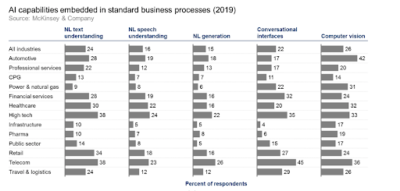The adoption of NLP in the enterprise has already been growing worldwide before the Covid-19 global pandemic. In 2021, Natural Language Processing is poised to grow significantly in enterprises as businesses invest more in digitalization and building data capabilities. Here are the key enterprise NLP trends to watch out for in 2021.
NLP in Enterprises: 4 Key Trends To Watch Out For In 2021
It might be a surprising fact that, despite the turmoil caused by Covid-19, with lockdowns and stunted business activities across the globe, the Natural Language Processing (NLP) global market size is projected to grow at a CAGR of 18.6% to reach $27.6 Billion by 2026. The market size was estimated to be $9.9 Billion in 2020. Experts believe these projections may be surpassed in reality as businesses invest more in digitalization and building data capabilities as markets place increasing emphasis on the inherent value of data.
The disruption caused by Covid has accelerated both the commercial and consumer market’s shift to digital environments and as a result, is a catalyst accelerating interest in NLP. More workers are operating remotely than ever before communicating primarily through email, chat, and online meetings. The primary mode of education in many cases transitioned from in-person to virtual. And the shift from retail stores to eCommerce is perhaps best exemplified by the fact that in 2020 alone Amazon doubled the number of businesses that transact through their platform.
The accelerated embrace of digital ecosystems is creating fertile ground for companies to explore, adapt, develop, or improve NLP solutions.
A few examples of NLP in practical everyday uses can be:
- Spam detection, this is how email providers can identify and filter spam content
- Sentiment analysis, to extract, analyze and respond to the emotion being conveyed through user-generated content
- Automated support, to be more responsive and accurate in understanding an individual’s problems and provide answers and guidance based on human input either voice or text (This is increasingly common in customer support calls and chat tools)
- Improved digital search, where users can search and obtain results based on the contextual and semantic meaning of their search queries
- Accessibility through voice assistants (Alexa, Siri, Google Home)
- Language Assistants and translation services
The adoption of NLP has already been growing worldwide as enterprises realized its various benefits and applications but have rapidly accelerated due to the growing interest in human-to-machine communications and the rising demand for data and enhanced algorithms.
A McKinsey survey from 2019 highlighted the different types of NLP based solutions that businesses were adopting. The image below shows the distribution of respondents from different industry sectors and their adoption of NLP.

Here are some of the key trends to watch out for in 2021 –
Key Enterprise NLP Trends in 2021
1. The democratization of NLP – 2021 may be the year that makes NLP affordable and accessible for all. The barrier for entry is set to get lower with the availability of pre-trained NLP models, multilingual NLP software, libraries, and APIs, ready for use in the research and development of new products.
Many barriers of entry to adopt NLP in enterprises such as high investments, deep research capabilities, and specialized skill requirements, etc., have become a thing of the past, and this year we may witness NLP going mainstream at full throttle.
The largest contribution to this space has been done by industry giants like Google who continuously publish results of their research based on their massive collections of user-generated data. This expedites the development process of smaller enterprises who can learn from such results and can also in some cases readily obtain models from the public domain built and trained on the large user data repositories.
2. NLP to unlock dark data – Dark data, the data that the enterprise collects but doesn't use in any way, accounts for 80% of all data generated. Common examples of dark include data in images, multimedia, scanned documents, spreadsheets, old files, emails, survey data, and social media content, etc. Businesses are slowly realizing that dark data can be a treasure trove of information and insights.
Such data typically will have some hurdles to get through before proper NLP techniques can be applied to them. The most common of such hurdles could be manual review to identify, label, annotate and tag the data sources properly so that they can be formed as training data sets for machine learning processes. However, as advancements in NLP grow and access to unstructured data becomes simpler, overcoming such hurdles is becoming simpler to convert unstructured data to cleaner data sets.
The industry segments that can benefit the most from insights derived from dark data are those that have historically relied more on manual processes or where data storage spanned multiple formats and systems, instead of digital consolidated data repositories. Healthcare, Education, Real estate, and Legal domains are good examples of dark data collectors and rightfully so all of these segments are looking to accelerate digital transformation in recent years.
3. NLP – driven Semantic Search – Businesses like Google, Amazon, etc., are already using semantic search to improve their search results and customer experience. Semantic search is a technique wherein the query not only delivers search results based on keywords but also considers the context and the intent behind the search. To state simply, Semantic search is the reason why we can type “where can I find something to eat near me” in Google and get a list of restaurants closest to us as a result. This is good because we do not have to be aware of the exact terms that would match the results we are trying to find and also reduces the gap in Human-Computer interaction with a more natural communication style.
- The challenge with Semantic processing is two parts, first, the volume of data
required to adequately train models processing language semantics is extremely high. The reason why Google, Facebook, and Amazon dominate this space is that their platforms are driven by natural language generated by users over the last couple of decades.
- The second challenge is enough variation and context in the data to allow the
models to get trained not just on the language based on their occurrence but also in the context in which they are generated. For example, the term “awful food” may imply something bad, however when used in the context of quantity such as “an awful amount of food”, it implies something greater than normal instead of something bad. It takes a reasonable amount of effort for machine learning models to learn and distinguish between these terms.
Another example, highlighted by Google in their blog, is searching for matching content in literary works. Searching for terms like “science fiction” should return results in futuristic content rather than traditional content based on “earth science” despite the latter having a direct match with one word.
Despite such challenges, and aided by research contributions, applications of Semantic processing are picking up with several advances mainstream already. Ask Siri if you are curious!
4. Next-gen chatbots – We have witnessed massive adoption of chatbots in businesses. Covid-19 has compelled many businesses to run with reduced staff and chatbots have been extensively and successfully used in 2020 to fill the staffing gap in areas such as customer services and virtual assistance. A GMI Research report projects the global chatbot market size to reach $4,860.8 million by the end of 2026, growing at a CAGR of 22.7% during 2019-2026. In 2021, advances in NLP will drive the development of next-generation chatbots and virtual assistants that self-learn, handle complex tasks, and engage deeply with humans. The growing usage of self-learning chatbots to collect customer feedback, monitor data and track buying patterns will further fuel the market’s demand. Self-learning chatbots have the ability to analyze data in real-time, provide exact information, and learn from their mistakes. The trend will continue in 2021 with NLP enhancing the understanding and thinking capabilities of chatbots.
Natural Language Processing is poised to grow significantly in 2021. Many enterprises are accelerating their digitalization plans and are exploring innovative ways to leverage data science technologies like AI and NLP to navigate through the current economic crisis.

